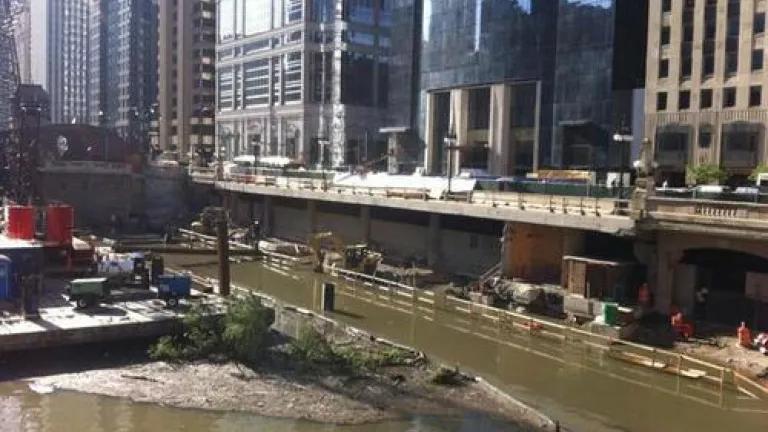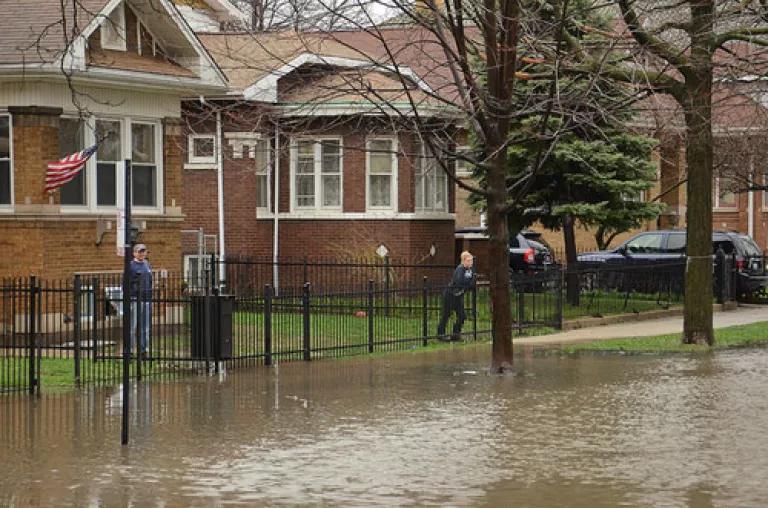
Days before the 4th of July weekend, the Chicago Park District closed every one of the city’s lakefront beaches, due to concerns about water pollution. Heavy rains had overwhelmed the city’s combined sewer system, pushing billions of gallons of polluted stormwater and partially treated sewage into the Chicago River, which re-reversed its flow and sent the tainted water into Lake Michigan. An earlier storm had similarly overwhelmed sewer systems a couple of months earlier, submerging highways and basements and forcing school closures all over northern Illinois. The previous year had been no different.
Flooding in downtown Chicago (credit: Marissa Bailey)
Like much of the country, Illinois will be seeing more days of heavy rains as the climate warms—as much as 30 percent more by the middle of the century. The city of Chicago has already weathered two 10-year storms in the past four years. Seeing the writing on the wall, Illinois Governor Patrick Quinn, who also serves on President Obama’s Task Force on Climate Preparedness and Resilience, recently signed legislation that encourages his state to prepare for a warmer, more flood-prone future. Illinois is one of just a handful of states that is starting to make climate-smart, water-smart investments a priority.

Spring floods in Chicago's Albany Park neighborhood (credit: Center for Neighborhood Technology, via Flickr)
For the first time, water efficiency, green infrastructure (such as green roofs and rain gardens), and other climate-resilient projects will be eligible for financing from a multi-billion-dollar state clean water fund, instead of having to rely on smaller grants. By making a bigger pool of capital available for sustainable water projects, and not merely for costly, traditional water infrastructure, Illinois is helping communities scale up their efforts to reduce flooding, protect drinking water supplies, and become more resilient to climate disruptions.
Illinois is also tackling water waste. Leaky, aging pipes waste about 14 percent of America’s daily water supply. More than 6 billion gallons of good water, treated at taxpayer expense, is lost every day, at a cost of about $2.8 billion every year. Many smaller and mid-sized utilities have no idea where their water goes. Over the next year, the state will provide technical assistance to communities to conduct water audits and help pinpoint waste.
Cities across the country that take advantage of water-smart strategies have done so with great success. In San Antonio, Texas, the water authority serves twice as many customers as it did 20 years ago—without having to pump out a single extra drop of water.
Efficiency made this feat possible. The San Antonio Water Service gave away efficient toilets, encouraged water-efficient landscaping, and used recycled wastewater to irrigate golf courses and keep the city’s famous River Walk from drying up. San Antonio has saved an estimated $1.1 billion in wastewater treatment costs by promoting water efficiency.
Green infrastructure—green roofs, roadside trees and plants, rain barrels, porous pavements and such—is another key, cost-effective water investment. Green infrastructure catches rainwater where it falls, instead of pushing it into beleaguered sewer systems. In addition to reducing flooding and protecting water quality, green infrastructure makes cities and neighborhoods greener, cooler, healthier places to live.
Onondaga County, New York, turned to green infrastructure to combat illegal sewage overflows and rehabilitate Onondaga Lake, which had been one of the most polluted lakes in the nation. Work crews rebuilt streets to include porous pavement in parking lanes, street trees, and other roadside plantings to soak up rainfall. Their efforts are keeping 8 million gallons of stormwater out of the sewer system each year. The Syracuse Crunch, the AHL ice hockey team, plays on ice made from rainwater collected from cisterns on site. Overall, the county’s Save the Rain program is expected to save $20 million compared to the cost of building traditional water infrastructure.
These communities (profiled in NRDC’s Rooftops to Rivers report) are just a few of those with the leadership and foresight to invest in sustainable, climate-resilient water strategies. But all over the country, water systems are outdated, inefficient, and not built to handle the needs of today’s population nor the threats of a warming climate. The nation’s wastewater infrastructure was given a D grade by the American Society of Civil Engineers.
The Federal Emergency Management Agency (FEMA) estimates that 20 to 25 percent of the costs of flooding are due to stormwater damage, not from overflowing rivers or coastal storms. Communities need cost-effective solutions to upgrade and build water systems that can better manage the heavy rains, floods and droughts that will become more frequent as the climate warms.
By investing in water-smart solutions and reducing water waste, Governor Quinn and the Illinois Legislature are putting the pieces in place to ensure a safer future for lllinois. Their proactive approach is a model for other states seeking to protect their citizens from flooding and disruptions in water supplies, and finding ways to build sustainable, resilient communities that are prepared to combat climate change.
